
Washington wine is a wine produced from grape varieties grown in the U.S. state of Washington. Washington ranks second in the United States in the production of wine. By 2017, the state had over 55,000 acres (220 km2) of vineyards, a harvest of 229,000 short tons (208,000 t) of grapes, and exports going to over 40 countries around the world from the 940+ wineries located in the state. While there are some viticultural activities in the cooler, wetter western half of the state, the majority (99.9%) of wine grape production takes place in the shrub-steppe eastern half. The rain shadow of the Cascade Range leaves the Columbia River Basin with around 8 inches (200 mm) of annual rain fall, making irrigation and water rights of paramount interest to the Washington wine industry. Viticulture in the state is also influenced by long sunlight hours and consistent temperatures.
The state of Oregon in the United States has established an international reputation for its production of wine, ranking fourth in the country behind California, Washington, and New York. Oregon has several different growing regions within the state's borders that are well-suited to the cultivation of grapes; additional regions straddle the border between Oregon and the states of Washington and Idaho. Wine making dates back to pioneer times in the 1840s, with commercial production beginning in the 1960s.
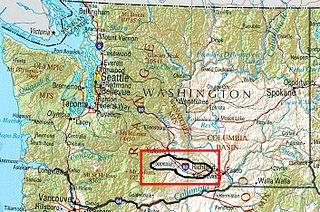
The Yakima Valley AVA was the first American Viticultural Area established within Washington state, gaining the recognition in 1983. Part of the larger Columbia Valley AVA, Yakima Valley AVA is home to more than 18,000 acres (73 km2) of vineyards, giving the area the largest concentration of wineries and vineyards in the state. The most widely planted varietals in the area are Chardonnay, Riesling, Merlot, Cabernet Sauvignon, Pinot gris, and Syrah. Nearly 40% of Washington state yearly wine production is made from Yakima Valley grapes. In addition to grapes, the Yakima Valley is also home to several fruit orchards growing apples, cherries, nectarines, peaches, pears and plums. Around the town of Zillah, there is the Zillah Fruit Loop driving tour through the area's orchards and vineyards. The area is also home to nearly 80% of the US hop production.

The Walla Walla Valley AVA is an American Viticultural Area located within Washington state and extending partly into the northeastern corner of Oregon. The wine region is entirely included within the larger Columbia Valley AVA. In addition to grapes, the area produces sweet onions, wheat and strawberries. After the Yakima Valley AVA, the Walla Walla AVA has the second highest concentration of vineyards and wineries in Washington State. Walla Walla hosts about 140 wineries.

Columbia Winery is a Washington state winery located in Woodinville, Washington. The winery is currently owned by E & J Gallo Winery. The winery was founded in 1962 as Associated Vinters by several former professors at the University of Washington. In 1979, the winery hired David Lake as head winemaker and under his stewardship, Columbia Winery was the first winery in the state of the Washington to produce varietal wines of Cabernet Franc, Pinot gris and Syrah. In 1983, the winery released wines under its current name. In 1988, the winery moved to its current location in Woodinville wine country. Due to failing health, David Lake retired from Columbia in 2006. In 2006, Kerry Norton (formerly of Covey Run Winery was hired as Directory of Winemaking. In June 2008, Columbia Winery were sold by Constellation Brands to newly formed Ascentia Wine Estates, which in turn sold Columbia to Gallo in 2012.

California wine production has a rich viticulture history since 1680 when Spanish Jesuit missionaries planted Vitis vinifera vines native to the Mediterranean region in their established missions to produce wine for religious services. In the 1770s, Spanish missionaries continued the practice under the direction of the Father Junípero Serra planted California's first vineyard at Mission San Juan Capistrano.
Valley View Winery is a winery in the Applegate Valley AVA in Southern Oregon, United States, founded in 1972.

Quilceda Creek Winery is a boutique winery in Snohomish, Washington specializing in premium Cabernet Sauvignon wine. The winery is named for a nearby creek in Snohomish County. Although the winery facility is located west of the Cascade Range, the winery sources all of its grapes from its four estate vineyards in the Horse Heaven Hills AVA and Red Mountain AVA. Quilceda Creek Winery has earned some of the highest reviews and awards of any winery in the United States and was the first American wine from outside of California to earn a perfect 100-point score from wine critic Robert Parker's publication The Wine Advocate. Since its founding in 1978, Quilceda Creek has received an additional seven 100-point scores from Robert Parker’s Wine Advocate, one 100-point score from Decanter (Magazine) and two 100-point scores from acclaimed wine blog OwenBargreen.com. In addition to critics' praise, one of the highest honors for Quilceda Creek happened when President Barack Obama chose to serve their 2005 Cabernet Sauvignon Columbia Valley at a White House dinner to President Hu Jintao of China in 2011.

British Columbia wine is Canadian wine produced in the province of British Columbia. Wines made from 100 percent British Columbia grapes can qualify for classification under one of British Columbia's two classification systems, depending on the variety, the wine-making techniques employed, and various other restrictions.

The Lake Chelan AVA is an American Viticultural Area (AVA) in Washington State. Located in the north-central part of the state around Lake Chelan, the area is a sub-appellation of the greater Columbia Valley AVA. Of the 24,040 acres within the AVA's boundaries, only 260 acres were planted with wine grapes which was producing wine for fifteen wineries as of 2009. While viticulture has existed in the region since 1891, the area was approved as a federally designated wine region in April 2009 when it became Washington's 11th AVA.
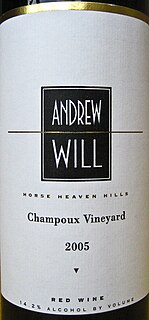
Champoux Vineyard is a grape growing estate located in the Horse Heaven Hills AVA of Washington state. Grapes grown in the vineyard have been used to produce some of the most critically acclaimed Washington wines with the name Champoux regularly being featured on vineyard designated wines. Paul Gregutt, wine writer for the Seattle Times and Wine Enthusiast, list Champoux as one of the "top ten" vineyards in the entire state. Cabernet Sauvignon grapes from Champoux vineyards were featured in the consecutive 100 point Robert Parker rated wines from Quilceda Creek Vintners for the 2002 and 2003 vintages.
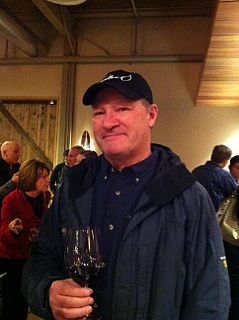
Boushey Vineyard is a grape-growing estate located in the Yakima Valley AVA, north of Grandview, Washington. Grapes grown in the vineyard have been used to produce some of the most critically acclaimed Washington wines with the name Boushey regularly being featured on vineyard designated wines. Paul Gregutt, wine writer for the Seattle Times and Wine Enthusiast, list Boushey as one of the "top ten" vineyards in the entire state. The vineyard is owned and managed by viticulturist Dick Boushey who was honored in 2002 by the Washington State Wine Commission as Washington's "Grower of the Year" and in 2007 by Wine & Spirits as their "Grower of the Year". After Red Willow Vineyard, which was planted with David Lake and Mike Sauer, Boushey was one of the first Washington wine growers to plant Syrah. Today, Boushey Vineyard is considered by wine experts such as Jon Bonné to be "One of the state's top Syrah spots" with many Washington Syrahs made from Boushey's grape receiving critical acclaim.

Cristom Vineyards is an Oregon wine producer and vineyard based near Salem, U.S. It is in the Eola-Amity Hills wine region within the Willamette Valley AVA, about 6 miles (9.7 km) northwest of Keizer.
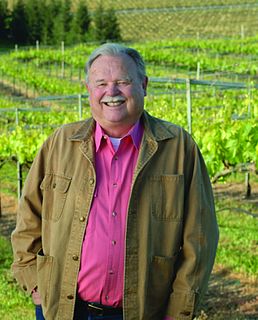
Cecil O. De Loach Jr. is a California grape-grower and winemaker in the Russian River Valley AVA who has contributed to the reputation and notoriety of Sonoma County viticulture.
Ahlgren Vineyard was a vineyard and winery located in the Santa Cruz Mountains AVA, in Boulder Creek, California, United States. Founded in 1976 by Dexter and Valerie Ahlgren, they produced 2,500-3,000 cases a year until their closure in 2016. The winery was located in the cellar of the Ahlgren's home. Ahlgren Vineyard used hands on, traditional methods of winemaking to create wine varietals including Sémillon, Chardonnay, Cabernet Sauvignon, Merlot, Cabernet Franc, Zinfandel, Nebbiolo, Pinot noir, and Syrah. Their grapes came from the Santa Cruz Mountains, Livermoore Valley, and Monterey. In 2000 Dexter Ahlgren suffered from a stroke, and the couples daughter, Beth Ahlgren, took over as winemaker. Dexter recovered enough to allow him to take part in the winemaking process.

The Naches Heights AVA is an American Viticultural Area contained within the Columbia Valley AVA. The AVA was recognized officially on 13 January 2012. Additionally, it is the first AVA in Washington state to be fully sustainable, with all 7 vineyards practicing in either biodynamic or LIVE certification. It is the smallest AVA in Washington with 37.2 acres (15.1 ha) planted.
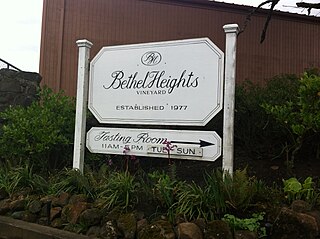
Bethel Heights Vineyard is an Oregon winery in the Eola-Amity Hills AVA of the Willamette Valley. Founded in 1977 by twin brothers Ted and Terry Casteel, their wives Pat Dudley and Marilyn Webb, and Pat's sister Barbara Dudley, the vineyard was one of the earliest plantings in the Eola-Amity Hills region. A winery soon followed, with the first estate wines produced in 1984. Bethel Heights specializes in Pinot noir, offering several individual block and vineyard designated bottlings, but also produces wines made from Chardonnay, Pinot gris, Pinot blanc, Riesling, Grüner Veltliner, and Gewürztraminer.

Red Willow Vineyard is a grape-growing estate located in the far western end of Yakima Valley AVA, within the Yakama Indian Reservation. Beginning with their relationship with Columbia Winery and Master of Wine David Lake, grapes from Red Willow have been used to produce some of the most critically acclaimed Washington wines with the vineyard's name regularly being featured on vineyard designated wines. Paul Gregutt, wine writer for the Seattle Times and Wine Enthusiast, list Red Willow as one of the "top ten" vineyards in the entire state.

Force Majeure is a Washington/Oregon wine estate, specializing in the growing and production of premium Syrah, Cabernet Sauvignon as well as other Bordeaux and Rhone-inspired blends. The brand was founded in 2004, and beginning with that vintage Force Majeure began the "Collaboration Series" of wines made by some of Washington's top winemakers, using fruit from Red Mountain's Ciel du Cheval vineyard, garnering much critical acclaim and attention for the brand.

Kenwood Vineyards is a winery in Kenwood, California, located on Highway 12 in the Sonoma Valley wine country. It is currently owned by Pernod Ricard Winemakers.


















